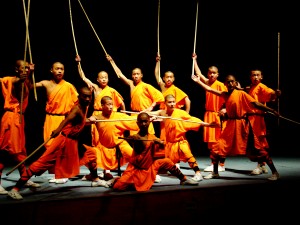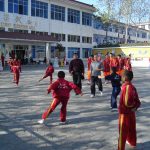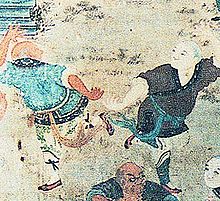Enter Kung Fu (功夫) Posted by Stephen on Sep 25, 2011 in Culture
 If you are like me, you love kung fu–in all its glory. No matter if it’s a Bruce Lee flick, a kickboxing match or if you’re just practicing some taichi (太极拳 pronounced: tài jí quán) in the back yard–kung fu kicks a$*. The hits, the flips, and who can forget the fumanchus? It’s the art of the simple, mastery of the menial and yet it’s also complex and mystifying.
If you are like me, you love kung fu–in all its glory. No matter if it’s a Bruce Lee flick, a kickboxing match or if you’re just practicing some taichi (太极拳 pronounced: tài jí quán) in the back yard–kung fu kicks a$*. The hits, the flips, and who can forget the fumanchus? It’s the art of the simple, mastery of the menial and yet it’s also complex and mystifying.
Sure, China lays claim to many ancient and historical aspects of technology, literature and culture, but the Chinese can still throw down when it comes to throwing down. After all, when you have centuries to hone your craft of physical fitness and crushing blows, the art of fighting reaches levels unrivaled by the rest of the world. So here’s a brief background on kung fu, it’s origins and it’s practice today.
Enter Kung Fu
Sure, the Egyptians invented the sweet science (boxing), the Greeks how to throw and grapple (wrestling/jiujitsu) and the Japanese…well how to break wood (sorry Karate). But the origins of a true ‘martial art’ date back to central Asia and the Silk Road where a mixture of boxing and grappling techniques blended into a fighting style involving both the arms and legs.
As the fighting styles mature and evolved, they crept further and further along the Silk Road eventually landing in what is now present day China. And, as the Chinese have done throughout history, they took these skills from the Silk Road (meditation and martial arts) and honed them into exceedingly complex, difficult and beautiful forms of self defense.
Kung Fu or 功夫 (gōng fu) is translated to mean a variety of things, including “art”, “skill”, “work” and “labor”. It is a broad term that encompasses many martial arts and forms of exercise and training that exist throughout all of China and Taiwan.
Kung fu really is the art of physical mastery– requiring perfect kinesthetic ability, balance, power and endurance. To do so, one must become completely in tune with their movements and motions, demonstrating grace, agility, and speed, while also demonstrating power and strength. But seeing as it is a martial art, a kung fu master must also “harden” themselves through tedious and painful exercises, dietary restrictions and sparring.
 Training is brutally meticulous and redundant. You may think you have mastered a style or stance, only to find that after 5 years of repetition and improvement, you’re still not quite there yet. Mastery of your body is a lifelong endeavor in kung fu. Each day is an opportunity for growth and improvement. You can always improve somewhere…or at least until you become a true kung fu “master” or 师傅 (shī fu).
Training is brutally meticulous and redundant. You may think you have mastered a style or stance, only to find that after 5 years of repetition and improvement, you’re still not quite there yet. Mastery of your body is a lifelong endeavor in kung fu. Each day is an opportunity for growth and improvement. You can always improve somewhere…or at least until you become a true kung fu “master” or 师傅 (shī fu).
Yet, within the physicality of kung fu, there is also a deeply mental aspect where one combines physical repetition with meditation and serenity or 宁静 (níng jìng) in what many Shaolin monks refer to as mind-body harmony. Therefore, control is the cornerstone of kung fu, both physically and mentally. Yeah I know it seems counter-indicative with all the screams, high-flying kicks and flips, but to be a kung fu master, is to have veins flowing with ice and a high threshold for pain.
The School of Hard Knocks
When it comes to learning kung fu, let me refer you to Carnegie Hall (it’s all about practice, practice, practice!). It’s relentless, redundant and repetitive, but that’s life in the kung fu world. You are a student, here to learn the “Analects” of physical mastery and believe me they’re more extensive that Confucius’.
If you want to graduate, you better work on your forms and hit the heavy bags whenever you get a chance. If you think high school is bad, forget it. Here the “teachers” are the ones who rough you up out on the courtyard. If you are fortunate enough to advance within these schools, the training only gets more intense.
Kung fu is a lot like academia in this regard and within the kung fu culture there is a mentor-mentee relationship with your 师傅 (master), who trains, advises and promotes your career in the world of kung fu (think of a stoic college adviser that smacks you through life). What 师傅 says goes, you just bow, acknowledge and hit the pads again. Seriously, you can spend your entire life learning the exact motions of just one form–and always be a centimeter off your poses and 师傅 will be there to remind you every time…
It just goes to show you how seriously they take kung fu in China. These top Shaolin monks that you see perform are some of China’s most gifted and talented athletes (many are gymnasts turned monks). Check them out:
Follow Steve on twitter: @seeitbelieveit

Build vocabulary, practice pronunciation, and more with Transparent Language Online. Available anytime, anywhere, on any device.
About the Author: Stephen
Writer and blogger for all things China related. Follow me on twitter: @seeitbelieveit -- My Background: Fluent Mandarin speaker with 3+ years working, living, studying and teaching throughout the mainland. Student of Kung Fu and avid photographer and documentarian.






Leave a comment: